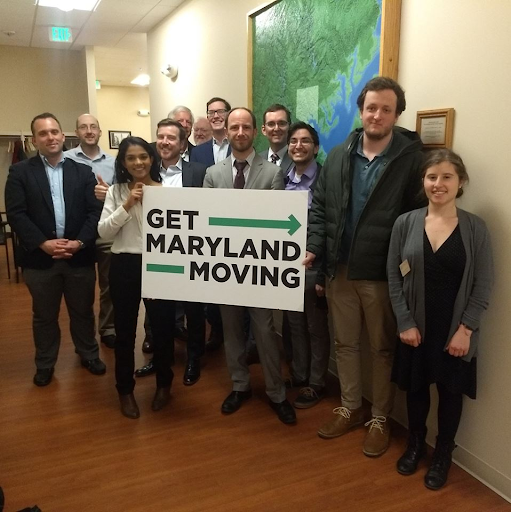Baltimore, MD -- On March 27th, the Sierra Club and other members of the Get Maryland Moving Coalition convened at the Baltimore Metropolitan Council to testify in support of a bold aggressive 25-year transit plan for the Greater Baltimore Region. As it’s now in its preliminary stages, the creation of this plan offers an incredible opportunity to lay out a new vision for the future of transit in this region. A robust and actionable regional transit plan has the potential to curb Maryland’s total carbon emissions, revitalize communities, and provide equitable and reliable transit for the residents of Maryland.
The transportation sector is now the largest source of carbon pollution (GHG) in Maryland. By 2030, Maryland has pledged to reduce its GHG emissions by 40%. Therefore, the transportation sector has to be a part of the solution. For the Greater Baltimore Regional Transit Plan, Transit needs to be better - faster, more frequent, and more reliable - in order for it to be considered a viable alternative to driving. We also need to identify transit needs and find innovative funding sources to meet those needs rather than existing in the funding constraints we currently have.
In the Baltimore region, an hour commute by car can get the typical resident to 100% of the region’s jobs. However, those living in zero-car households can reach only 9% of the region’s jobs within the same time frame. Overall, in Baltimore 30% of households lack access to a car. In every historically red-lined, majority African-American community in Baltimore city, the percentage of households with no access to a car is above 50% - but this figure climbs as high as 71% in certain “historically disenfranchised neighborhoods”. In sum, 9 out of 10 jobs are either out of reach or have an incredibly long commute, and this disparity largely exists along racial lines.
Repeatedly, data has shown commute times are the single largest factor in the odds against escaping poverty and is strongly correlated with neighborhood decline. So it’s no surprise that among the 100 largest counties in the United States, Baltimore City has the worst odds of children escaping poverty. The most vulnerable neighborhoods in Baltimore are essentially cut off from jobs and opportunities that are located on the other side of the city. A comprehensive regional transit plan will not only address these concerns but actively work to combat them by providing better connections to key job centers.
Up to this point, the focus has tended to lean more towards highway development and less towards transit. In 2019, for example, the State Highway Administration is to receive over 40% more capital funding than the Maryland Transit Administration. Considering 60% of Baltimore residents don’t have access to a bus stop within a ¼ mile or rail stop within a ½ mile of their homes, MDOT must reverse the trend of auto-centric development in the Baltimore area. Increasing the development of public transportation will also slow down Maryland’s GHG emissions and help push Maryland closer to its 2030 GHG emission goals.
At the meeting, MDOT said the plan is set to be published in September 2020 and has the potential to revamp the transit system. Prior to this commission, the last transit-based vision for the Baltimore region was created in 2002 with very little public involvement. The public, especially transit riders, should have a voice in this process. With meaningful public engagement, MDOT and state and regional leaders have the opportunity to fill this need that has gone so long unfunded. With the creation of a comprehensive, all-inclusive plan, Baltimore can become the poster child for efficient and effective transit-based models of the 21st century.
